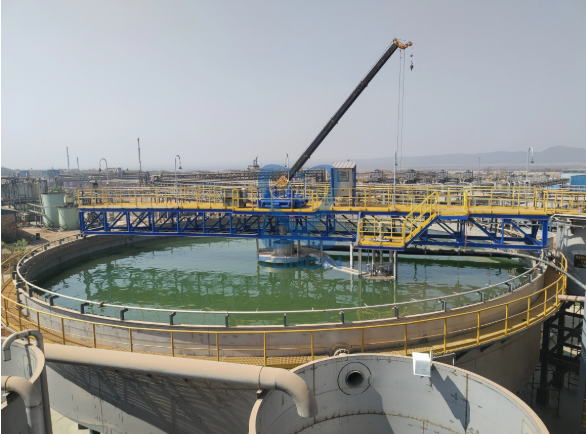Can your thickener meet production goals? High rate thickeners control underflow concentration. They ensure steady throughput and reliable operation. In this article, we explore key factors and strategies. You will learn how to optimize thickener performance.
Understanding Underflow Concentration and Throughput
Key Performance Indicators of a High Rate Thickener
Underflow concentration and throughput are vital for plant productivity. The High-rate thickener underflow concentration determines the density of solids in the underflow stream, which directly affects downstream pumps and equipment. Throughput measures the volume of slurry processed per hour, reflecting the thickener’s capacity.
Key metrics include:
Importance of Consistent Underflow Flow
Variations in feed concentration can create operational inefficiencies. Fluctuating underflow density may strain pumps and increase maintenance. Maintaining stable flow ensures continuous production and prevents damage to sensitive downstream systems.
Tip: Regularly calibrate density meters and flow sensors to maintain consistent underflow performance.
Common Operational Challenges
High solids content can cause wear in standard pumps. Blockages or obstructions reduce throughput and force unscheduled downtime. High rate thickeners must handle variable slurry properties without compromising performance. Peristaltic pumps can process slurries up to 80% solids without damaging components, ideal for variable feed conditions.
Measuring and Monitoring Key Variables
Accurate online measurement of underflow density, bed level, and flow rate allows operators to respond to changes quickly. Combining sensor data with real-time monitoring improves decision-making and reduces downtime.
Selecting the Right High Rate Thickener
Types of High Rate Thickeners
Conventional Thickeners: Suitable for low to moderate solids content.
High-Rate Thickeners: Designed for higher underflow densities and throughput.
Paste Thickeners: Ideal for non-settling, high-density slurries.
Deep Cone Thickeners: Effective where particle settling rates vary.
Tip: Match thickener type to feed characteristics and desired underflow concentration.
Factors Influencing Selection
Selection depends on:
Desired underflow density
Feed particle size and solids loading
Available space and tank dimensions
Production capacity requirements
Annotation: A misaligned thickener type can reduce throughput and increase operational costs.
Case Studies of Effective Selection
Mining operations often achieve better results by selecting thickeners tailored to their feed properties. Proper selection improves underflow consistency, reduces maintenance, and enhances overall process efficiency.
Design Considerations for Optimal Performance
Feedwell Design and Optimization
A well-designed feedwell ensures even slurry distribution. This prevents short-circuiting and promotes uniform settling. Use baffling or dilution mechanisms to optimize feed distribution.
Settling Zone and Tank Geometry
Depth and floor slope directly influence solids settling. Larger tanks with optimized slopes enhance underflow density and reduce overflow turbidity.
Rake Design and Underflow Discharge
Rakes remove solids continuously without disturbing the settled bed. Proper rake speed and torque prevent overloading and maintain consistent throughput.
Integration with Pumping Systems
Peristaltic or positive displacement pumps complement High rate thickeners, handling high solids content without damage or downtime.
Annotation: Pumps in situ reduce maintenance complexity and operational interruptions.

Operational Strategies to Maintain Optimal Underflow
Feed Flow Control
Maintaining constant feed rates stabilizes underflow concentration. Variations in feed can cause density swings, affecting pump efficiency. Implement automated flow control valves to maintain steady feed.
Flocculant Dosing Optimization
Proper flocculant dosage improves solids aggregation, enhancing settling efficiency and underflow quality.
Rake Speed and Torque Management
Adjusting rake speed ensures effective solids removal. Monitoring torque prevents mechanical failures and maintains throughput.
Automation and Process Control
Modern systems monitor key variables and adjust flocculant dosage, feed dilution, and underflow discharge automatically. Automation reduces human error and improves repeatable performance.
Performance Monitoring and Optimization
Key Metrics to Track
Operators should continuously monitor:
Underflow density
Overflow clarity
Bed levels
Rake torque
Feed and dilution rates
Laboratory and Online Testing
Regular sampling of feed, underflow, and overflow streams helps verify sensor accuracy and optimize performance.
Tip: Use trending and historical data to predict deviations and prevent production loss.
Advanced Optimization Techniques
Model predictive control (MPC) and expert systems use historical data and real-time measurements to optimize thickener performance dynamically.
Maintenance Practices
Routine inspection of rakes, drives, and feed systems prevents unexpected failures. Proper lubrication and alignment extend equipment life.
Annotation: Short downtime schedules maximize operational efficiency.
Achieving Production Targets with High Rate Thickeners
Linking Underflow Performance to Production Efficiency
Higher underflow concentration translates to increased downstream productivity. Optimizing both underflow and throughput reduces energy consumption and chemical costs.
Overcoming Common Bottlenecks
Address high solids content, variable feed, and pump limitations to ensure consistent production. Optimized High rate thickener underflow concentration reduces downtime and improves reliability.
Real-World Examples
Mining operations have improved profitability by switching to high-rate thickeners with precise monitoring. They report lower water usage, better tailings management, and more stable production output. Benchmark thickener performance against historical data to identify improvement opportunities.
Conclusion
Selecting the right High rate thickener ensures consistent underflow and throughput. TONCIN products optimize feed and settling zones efficiently. Continuous monitoring and automation reduce costs. Their solutions support sustainable and reliable mineral processing operations.
Table: Key Factors Affecting Thickener Performance
| Factor | Impact on Underflow & Throughput |
| Feed rate | Directly affects underflow consistency |
| Solids concentration | High solids can overload pumps |
| Flocculant dosage | Improves settling efficiency |
| Rake speed & torque | Ensures continuous solids removal |
| Automation & sensors | Reduces human error & optimizes flow |
FAQ
Q: What is a High rate thickener?
A: A High rate thickener separates solids from liquids efficiently and controls underflow concentration.
Q: How can I optimize High-rate thickener underflow concentration?
A: Adjust feed rate, flocculant dosing, and monitor bed levels for consistent density.
Q: Why is underflow concentration important for production?
A: Proper underflow ensures smooth pumping and maintains throughput to meet production targets.
 English
English






























